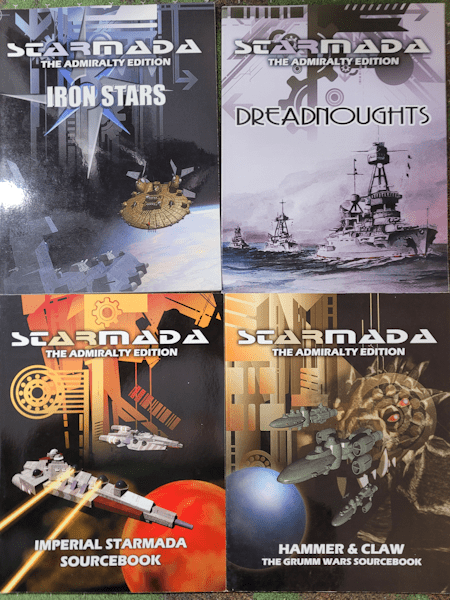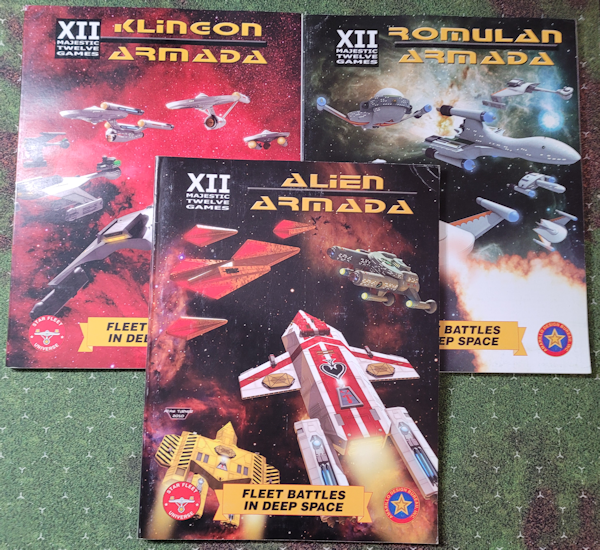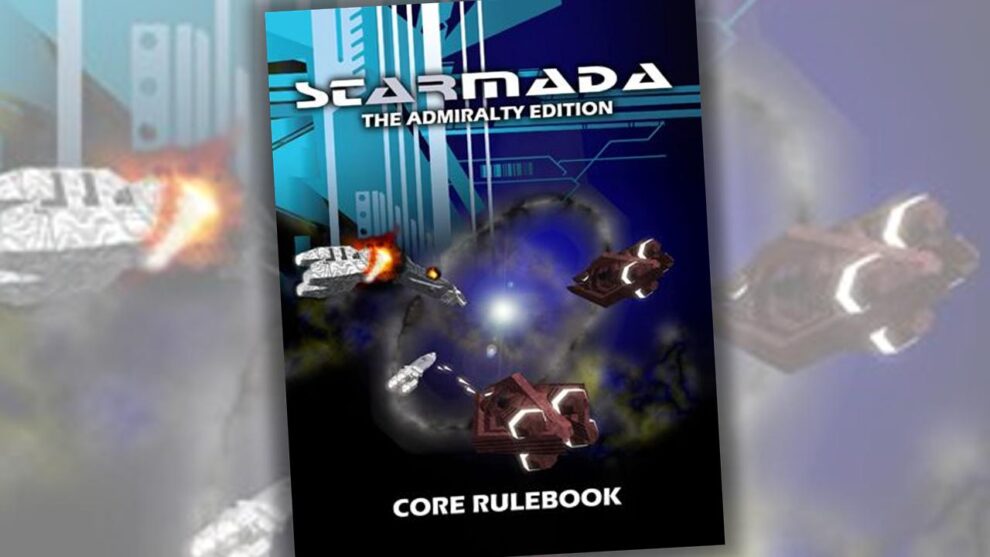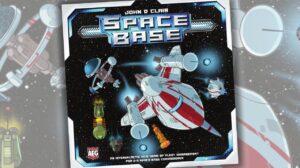Starmada is a set of rules that allows you to design starships, then (with some miniatures or chits on a hex grid) send them out to reduce other starships to so much space debris. The idea of the game is to be a quick playing, tactical, and universal set of rules for such things. The system for ship design has basic components and myriad add-ons allowing it to simulate just about anything you can think of in a way that ensures that even if you and your friends are simulating different universes, the relative strengths of the ships can be calculated to ensure a fair fight. Want to put a fleet of Star Wars Super Star Destroyers up against a group of Star Trek Borg Cubes or perhaps a few Babylon 5 Vorlon Planet Killers? This game can do that.
Disclaimer: I am a member of the Admiralty—the group of volunteers that Daniel Kast (Majestic XII Games) brought together to take Starmada X rules and use them to create a new edition of Starmada a bit over a decade ago. Daniel and the members of the Admiralty were all people that loved many of the previous editions of the game. We each had our thoughts on where the strongest and weakest areas of the Starmada rules were located. And in the end, Daniel Kast created something that we could all look at proudly and proclaim that we were a part of that game’s evolution.

Starmada is a game that is simple but not simplistic. I have to say, when I first read that claim some time ago, I was very skeptical. Then again, I had played a game with detail and complexity galore: Starfleet Battles. Nothing like a game that has a 500+ page rulebook to make you appreciate the beauty of having nuanced rules and subtle elements. I love Starfleet Battles to this day. I am a Romulan player, through and through.
But as I have gotten older, and my time is having to be divided into smaller and smaller chunks, games like Starfleet Battles sit on my shelf and collect dust. I cannot devote the time it takes to set up and play such a game these days. So I was looking for alternatives.
Then I stumbled onto Starmada.
This was pre-Starmada X. I had the Compendium and started toying with it. I played several games; it was on game three that I fell in love with it. I had resisted using the Brian Rule (a rule that Starmada uses for movement). Once I agreed to use it, the game was an instant success with me and my game group.
I started emailing Daniel Kast and we had some great conversations about the game. I was involved in a contest that ran to design some ships for a product called Brigade for a miniatures company. I was very close to winning, but I shifted my own vote at the end. One of my competitors had made some designs I thought were better than mine. In the end, I lost by one vote. Had I kept my vote for myself… I would have won. Such is life.
So when I was asked to be a part of the Admiralty, how could I say no?
Essential Starmada
Chapters 1-5
The rules of Starmada, in The Admiralty Edition, are organized as follows:
- Chapter 1 explains how to read a ship data card.
- Chapter 2 explains the basic play of the game (basic game setup, turn sequence, victory conditions).
- Chapter 3 explains the basics of star ship movement.
- Chapter 4 explains the basics of star ship combat (firing arcs, to-hit, defenses, damage).
- Chapter 5 explains fighters and other small-craft and how they are used in the game.
Before I go on, I should point out that the five chapters above are 15 pages long. This includes 11 large images, some large-font charts, as well as multiple example boxes. All in all, the game to this point takes up about 6-7 pages or so of text. In other words, you can learn to play this game in a few minutes. Because everything that follows this in the book is optional.
Prior to all of this is Chapter 0, which covers the organization of the book, the history of the game, where to get some miniatures, where to get a good space-themed hex grid mat, some information on the terminology used, and so on. Along with the Table of Contents, title and copyright pages… you are up to page 26 of this 84 page book.
To be honest, if you want to use any of the pre-made ships in the back of the book, you are virtually done reading. You can start playing right now. There are about a dozen ships pre-defined in the book that use no rules other than those in the first five chapters. This is because Dan decided that the core of the book would be ‘essential Starmada’—the rules that define the game, with none of the frills.
Chapter 6: A Toolkit
If you just want a good, fast-paced, simple starship game with some real tactical choices to be made with each turn… you are done. You need go no further.
But Dan created Starmada to be a game and a toolkit for making your own universe. In other words, the game has a whole slew of options that can be used individually or as a group to make Starmada your game, all while remaining completely compatible with other visions of Starmada.
Chapter 6 begins the toolkit. This is the simple system for creating your own star ships. From small patrol boats to massive star destroyers, you can create anything you would like with the rules presented in this 5-page chapter. You can design the armor/shields, engines, weapons, the defenses, and the other systems to your liking.
The best part of this chapter (and all of Starmada) is the absolute care to ensure that the math works out simply and honestly. So what do I mean by that? Glad you asked.
- Simply: The math is generally basic stuff, nothing too complex. Where the math is required to be a bit more complex, Dan (with one exception) breaks it down to simple charts or elements that can be calculated easily. To design a ship in this system, all you need is a piece of paper and a pencil. Then, if you are going to get the final combat value of the ship, any calculator will do, as this part needs a square root.
- Honestly: I cannot tell you how many times I have played games where a “combat value” is assigned, and it becomes evident after a short while that these numbers were pulled from the author’s nether regions. I have examined the math used, I have discussed it with Dan… in the end, if a ship has a value of 100 and it is going up against another ship with a value of 100 then they are evenly matched. Period.
Beyond the Essentials
So once you get past the essential rules—the rules that form the foundation that everything else in Starmada is grounded to—you get to see the true beauty that is Starmada!
- Appendix A is the listing of all other options. This is the listing that tells you where to look if you are looking for a particular option. This appendix is kept up to date with each additional release on the Majestic XII Website.
- Appendix B explains a dozen options for customizing the ship as a whole: adding in armor plating, electronic countermeasures, mines, cloaking devices, and so on. Each one explains how that option can be employed, how it impacts the combat value of the ship, and so on.
- Appendix C explains more than two dozen options that can be added to any given battery of weapons such as area effect, piercing, repeating, and so on. Between the basic stats of a weapon (Range, Accuracy, Rate-Of-Fire, Impact, and Damage) and the ability to put up to three options on the weapon (more, if you want to use optional rules) there are literally millions upon millions of possible weapons you can make.
- Appendix D explains some optional rules for handling movement.
Before we go on, a little history: In the early editions of Starmada, Dan used a very simple, non-inertia-based movement system as the core rule. He included several options for pseudo-inertia, full inertia, and so on. Many people were hung up on the simple movement rules and criticized the game for it even existing, let alone as the core rule.
The inertia system Dan originally used required a rather cumbersome chart to be used effectively. Dan did not want to begin using multiple counters for current and ending locations the way some games did as it seemed just as cumbersome and more cluttered when playing.
So Dan examined the chart for a true inertia system and stripped it down by locating the underlying math and breaking it into 4 possibilities:
- #1: You are going straight. Thrust equals acceleration/deceleration.
- #2: You are turning 60° starboard or port. Thrust is the greater of the starting and ending speeds.
- #3: You are turning 120° or 180° starboard or port. Thrust is the sum of the starting and ending speeds.
- #4: You are slipping to the port or starboard (i.e., you are turning port and then starboard, or starboard and then port). Thrust is the difference between starting and ending speeds, plus the distance between the two turns.
Believe me when I said I checked every possible combination of this particular system and the math is correct. This makes the calculation of thrust in game very, very simple and easy to do in your head. However, if this is not your cup-o-tea…
As I said, Appendix D offers you all sorts of options for movement, including the Starmada Classic simple movement, rules for turning when you do not have all the thrust right now (delayed turns), using emergency thrust, evasive maneuvers, or even true side-slips (i.e., option #4 without the whole two-shifts in vector required), and so on.
- Appendix E is to combat what Appendix D was to movement. This one gives you rules for damage control parties, ship explosions, advanced uses of sensors, reinforced shields, and so on.
- Appendix F explains how to design fighters. In the essential rules, fighters are generic combat small-craft. Here you can customize them to a degree that is quite similar to weapons customization in Appendix C. Literally, millions of types of fighters can be created here. Additionally, rules for dogfights, launch and recovery, and specialty fighters are presented.
- Appendix G explains terrain. Want to play in an asteroid field? How about around a giant black hole? Perhaps you want to test out the whole “battle in a nebula” (a’la Star Trek) concept? This chapter tells you how.
After this is a section of some scenarios, how to convert from Starmada X, and some pre-built ships.
Playing the Game
Playing the game is pretty straight forward. You plot out your movement (meaning you decide how much you want to change your speed or your heading and write that down). Ships are then moved based on the plot. Ships that then have enemies in the correct arcs and range can fire. Roll to hit. If you hit, roll for the damage the weapon caused. Reduce that if armor or shields are going to impact things. Record any resulting damage. It really is as quick and simple as that.
That said, in that simple description lies a series of tactical choices that need to be made in order to ensure you are at your optimal range, not theirs; that you have them in the arcs where you can fire the most weapons, and they are not; and so on. It is a beauty and a wonder to behold how well this game plays.
Conclusion
Starmada is (despite my description above) a very simple game. The vast majority of the math is handled at star ship design time. Thus, in order to play, the most you have to do is figure out that “since I am turning one-hex facing to the right and I started at a speed of 3 and ended at a speed of 4, I need … 4 thrust, since that is the larger of the two speeds.”
However, as Dan claims: the game is simple, but not simplistic. And he is right. The game is not simplistic in any way. You have many tactical choices to make in a turn. And the game moves very quickly.
The customization tool kit of the game lets you create ships from Star Trek, Star Wars, Battlestar Galactica, Babylon 5, Star Blazers, or what have you. You can have them all working with a framework of their own universe and still have the game be (essentially) Starmada when it is all over… so they can fight each other if you want.
In fact, he has a few books for house settings, such as the Imperial Starmada setting, the Grum Wars setting, and one for a more eccentric setting called Iron Stars, etc.:

He has even teamed up with the folks over at Starfleet Games to make some books for a setting that might look a little familiar:

Starmada is a great game. I highly encourage you to check it out.
But Wait! There’s More!
Since my days of working on this little project, Dan has not stopped working to refine things. There have been the Nova Rules, the Unity Rules, and his latest edition of the Core Rulebook. Although I still play (and enjoy) the Admiralty Edition, each of these is wonderful! His most recent release of the Core Rules might convert me… not sure yet.











